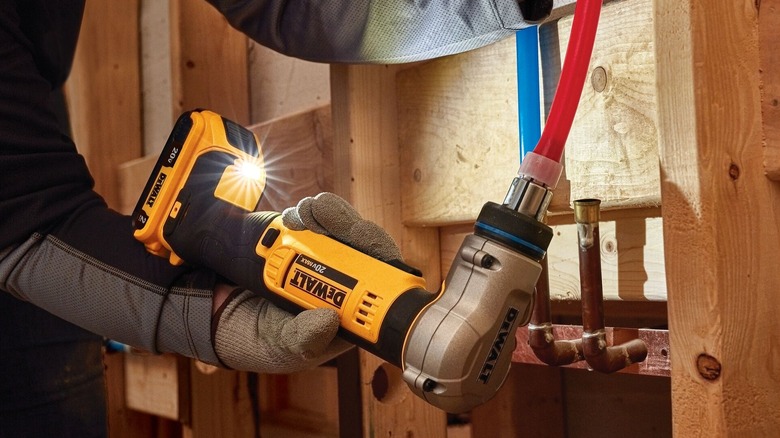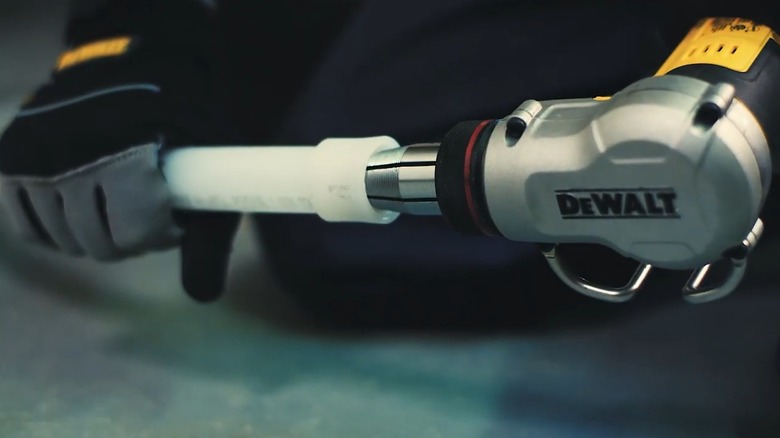What Is DeWalt's PEX Expander Tool? (And How Do You Use It?)
We may receive a commission on purchases made from links.
Your home's plumbing system is an integral component of modern everyday life. Unfortunately, because much of it resides behind the wall's unseen, it's often forgotten, until something goes wrong. Nearly a century ago, copper piping began appearing in homes and can still be found today in some cases. Up until the late 90s, copper was the go-to material due to its resistance to corrosion and time-tested reliability. However, just before the turn of the 21st century, cross-linked polyethylene (PEX) became popular in new construction. Essentially a semi-malleable plastic piping, PEX is easier to run as it can bend, and doesn't require soldering the fittings like copper.
There are different types of PEX, but increasingly, PEX A is becoming a preferred material because of its many advantages. Making connections on PEX A involves using a specific tool like one of DeWalt's PEX Expanders. If you've never heard of this product before, you're not alone, as there are several high-tech DeWalt tools and products you probably didn't realize exist.
In order to install a fitting into PEX A, an expander head from the expander tool is inserted into the end of the pipe. Then, a press of the tool's trigger causes the head to create outward pressure to increase the tube's diameter, which, according to owners, only takes around 15 seconds. Following expansion, a full-size fitting can be installed.
Features of DeWalt's PEX expander tools
DeWalt offers two different models of PEX expander tools, the 20V MAX* XR 1-1/2 in. PEX EXP (DCE410B), which is available for $449 from Lowe's, and the 20V MAX* 1" PEX Expander Tool (DCE400B) listed for $390 on Amazon. However, this only includes the tool itself, so you'll need to purchase a battery and charger separately.
Both expanders feature an automatic rotating head, which enables an equal amount of expansion all the way around the pipe. In addition, each unit offers an LED light that illuminates once the trigger is held, which is especially helpful in dark recesses where plumbing is typically installed. Lastly, these tools also share an elongated ergonomic grip and a convenient built-in hook, so you can hang them up on a typical tool rack.
The differences between the two models, beyond price, are the sizes each tool accommodates. For example, the pricier model (DCE410B) expands 1-1/4 inch and 1-1/2 inch PEX A pipe. The less expensive unit (DCE400B) expands 3/8 inch to 1-inch PEX A tubing. Of course, PEX expanders and crimpers aren't the only products from this brand worth looking at, as there are several affordable DeWalt tools that belong in every homeowner's toolbox.
The difference between PEX A, B, and C
PEX expander tools only work with PEX A, and that has to do with its enhanced flexibility and shape memory behavior. Following the use of an expander, not only does PEX A provide a greater flow rate due to using full-size fittings, but it also creates an extremely water-tight connection. The unique quality of PEX A piping is that it continually attempts to shrink back down to its pre-expanded size, ever tightening over the installed fitting. Also, due to its pliable nature, a kink in a PEX A pipe can be repaired using a heat gun.
Another commonly used plumbing pipe is PEX B, which uses a different method for connections. Instead of an expander, PEX B instead requires smaller fittings that fit inside the pipe, and then a compression ring that's crimped to seal the connection. And yes, DeWalt does make a PEX crimper tool. Unfortunately, PEX B doesn't offer near the same elastic qualities as PEX A, and therefore, if expansion occurs due to freezing, PEX B isn't able to shrink back down. In fact, if this version of PEX incurs a kink, it can't be repaired, and that section of pipe must be removed.
According to plumbing professionals, PEX C isn't used very often as it's much stiffer and more difficult to work with than the other types. While it is the least expensive option, PEX C is really only good for short and straight runs. It's not ideal for extensive use as it's particularly prone to developing cracks or kinks.


